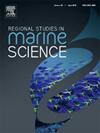爪哇海盘江岛海岸沉积物中微塑料垂直剖面
IF 2.4
4区 环境科学与生态学
Q3 ECOLOGY
引用次数: 0
摘要
塑料污染的扩散导致海洋生态系统中微塑料(MPs)的广泛积累。虽然对地表沉积物污染的研究相对较好,但对沉积物柱内垂直MP分布的了解仍然有限。本文研究了爪哇海盘jang岛潮下和潮间带沉积物中MPs的丰度、垂直分布和特征。使用显微镜和ATR-FTIR分析了15个浅层(10 cm)和3个深层(~ 100 cm)沉积物岩心的MP丰度、形态、大小、颜色和聚合物。在所有岩心中均检测到MPs,表层沉积物中MPs的平均浓度为0.49 ± 0.28 MPs g⁻¹ 。最高的地表浓度(2.08 ± 0.22 MPs g⁻¹)发生在西南,一个受人为影响较大的隐蔽地点,而最低的(0.05 ± 0.07 MPs g⁻¹)发生在西北,一个偏远和不受干扰的地区。纤维颗粒类型占主导地位。白色、黑色和蓝色是最常见的颜色,尺寸分布向颗粒<;1 mm倾斜。聚丙烯和聚乙烯是最常见的聚合物,反映了它们的广泛使用和持久性。垂直剖面显示地表附近的多聚磷浓度较高,表明近几十年的输入增加。在70 cm以下没有检测到MPs,表明有限的向下迁移,标志着塑料时代污染的开始。本研究还在较深的沉积层中发现了MPs,可能是由于沉积后的过程,如生物扰动。这些发现表明,沉积物岩心是历史MP沉积的宝贵档案,可以捕捉全球生产趋势和当地环境影响,并为有针对性的管理策略提供基础。本文章由计算机程序翻译,如有差异,请以英文原文为准。
Vertical profiles of microplastics in coastal sediments of Panjang Island, Java Sea
The proliferation of plastic pollution has led to the widespread accumulation of microplastics (MPs) in marine ecosystems. While surface sediment contamination is relatively well studied, knowledge of vertical MP distribution within sediment columns remains limited. This study examines the abundance, vertical distribution, and characteristics of MPs in subtidal and intertidal sediments of Panjang Island, Java Sea. Fifteen shallow (10 cm) and three deep (∼100 cm) sediment cores were analyzed for MP abundance, morphology, size, color, and polymer using microscopy and ATR-FTIR. MPs were detected in all cores, with an average concentration of 0.49 ± 0.28 MPs g⁻¹ in surface sediments. The highest surface concentration (2.08 ± 0.22 MPs g⁻¹) occurred in the southwest, a sheltered site with greater anthropogenic influence, while the lowest (0.05 ± 0.07 MPs g⁻¹) was recorded in the northwest, a remote and less disturbed area. Fibers dominated particle types. White, black, and blue were the most common colors, and size distributions were skewed toward particles <1 mm. Polypropylene and polyethylene were the most frequent polymers, reflecting their widespread use and persistence. Vertical profiles revealed higher MP concentrations near the surface, indicating intensified inputs in recent decades. No MPs were detected below 70 cm, suggesting limited downward migration and marking the onset of contamination during the plastic era. This study also found MPs in deeper sediment layer, likely due to post-depositional processes such as bioturbation. These findings demonstrate that sediment cores serve as valuable archives of historical MP deposition, capturing both global production trends and local environmental influences, and provide a basis for targeted management strategies.
求助全文
通过发布文献求助,成功后即可免费获取论文全文。
去求助
来源期刊

Regional Studies in Marine Science
Agricultural and Biological Sciences-Ecology, Evolution, Behavior and Systematics
CiteScore
3.90
自引率
4.80%
发文量
336
审稿时长
69 days
期刊介绍:
REGIONAL STUDIES IN MARINE SCIENCE will publish scientifically sound papers on regional aspects of maritime and marine resources in estuaries, coastal zones, continental shelf, the seas and oceans.
 求助内容:
求助内容: 应助结果提醒方式:
应助结果提醒方式:


